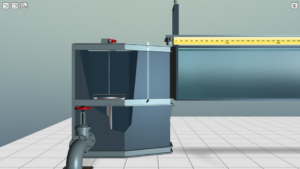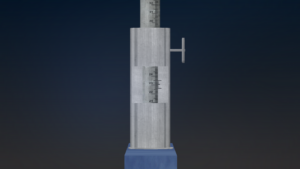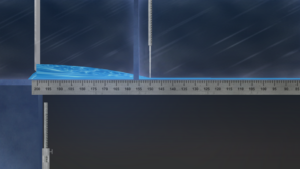
General Description of the Software Product
Software laboratory complex for the simulation of laboratory work on the main sections of the course of Open Channel Hydraulics for technical specialties.
The laboratory complex includes two computer models. The first model simulates a glass hydraulic channel 15 m long, 0.4 m wide and 1.0 m high. The second model simulates a glass hydraulic channel 2 m long, 0.28 m wide and 0.5 m high.
List of virtual labs:
1. Determination of the Roughness Coefficient of the Open Prismatic Channel
2. Estimation of Energy State of Flow and Calculation of Free Surface Curves
3. Determination of the Flow Coefficient of a Rectangular Spillway with a Thin Wall
4. The Study of the Flow of Water through a Weir with a Wide Threshold
5. Determination of the Coefficients of Spillway Consumption of the Practical Profile
6. The Study of the Flow of Water from the bottom of the Pressure Port (From Under the Shield)
7. The Study of the Hydraulic Jump
8. Study of Free Surface Curves of the Liquid in a Short Hydraulic Channel
Target computing device type and platform supported: IBM-compatible personal computer running Microsoft Windows.
The graphics component of the software uses the Microsoft DirectX 9.0.c component base. The graphical user interface of the program is implemented in English.
Minimum System Requirements
- Processor clock speed: at least 1.5 GHz
- RAM: at least 2 GB
- Video memory: at least 256 MB
- Screen resolution: at least 1024x768x32
- DirectX version 9.0.c support
- Standard keyboard and computer mouse with scroll wheel (for PC)
- Audio playback devices (audio speakers or headphones)
Types of Licensing
The Virtual Lab is supplied only for educational organizations with installation on an unlimited number of places (corporate license).
Screenshot Gallery (Long Channel Model)
1. Determination of the Roughness Coefficient of the Open Prismatic Channel
OBJECTIVE: The determination of the value of the roughness coefficient of the open channel of rectangular cross section by experimental data. SUMMARY: The laboratory stand is represented by a hydraulic channel 15 meters long, equipped with two flat closures, two measuring needles, a ruler, a lifting mechanism for setting the bottom slope, a pressure tower and a flow-measuring tank. Water flow in the system is measured using a stopwatch.
2. Estimation of Energy State of Flow and Calculation of Free Surface Curves
OBJECTIVE: The determination of the energy state of the water flow in the open channel and construction of the free surface curves using the experimental data; the determining the type and shape of the free surface flow curves according to the depth measurement data at various points along the length of the flow; the comparison of empirical data with theoretical and determination of discrepancy. SUMMARY: Laboratory work is carried out on a hydraulic channel 15 meters long, equipped with two flat closures, two measuring needles, a ruler, a lifting mechanism for setting the bottom slope, a pressure tower and a flow-measuring tank. Water flow in the system is measured using a stopwatch. In the process, the flow depth is measured along the entire length of the tray design.
3. Determination of the Flow Coefficient of a Rectangular Spillway with a Thin Wall
OBJECTIVE: The experimentally determination for a rectangular weir with a thin wall of the flow coefficient and comparing it with a theoretical value. SUMMARY: Laboratory work is carried out on a hydraulic channel 15 meters long. At a given distance from the flat shield of the upper pool, a special design is installed in the channel ‒ a rectangular weir with a thin wall. The flow of water overflows through the weir, forming a free surface of a certain shape. With the help of measuring needles, the flow depths in the upper and lower pools are measured.
4. The Study of the Flow of Water through a Weir with a Wide Threshold
OBJECTIVE: The experimentally determination data for weirs with a wide threshold of the discharge coefficient and the flooding coefficient and their comparison with theoretical values; the construction the curves of the free surface flow on the experimental data. SUMMARY: Laboratory work is carried out on a hydraulic channel 15 meters long. At a specified distance from the flat shield of the upper pool, a special design is installed in the channel ‒ a weir with a wide threshold. The flow of water overflows through the weir, forming a free surface of a certain shape. With the help of measuring needles, the flow depths in the upper and lower pools are measured. Several models of flow flow are considered, including the situation with flooded overflow.
5. Determination of the Coefficients of Spillway Consumption of the Practical Profile
OBJECTIVE: The determination of the practical profile of the flow rate and the coefficient of flooding on the basis of experimental data for the weir and comparing them with theoretical values; measurement of the surface marks of the jet on the water discharge face at 4 points; the construction of the free flow surface profiles on the experimental data. SUMMARY: Laboratory work is carried out on a hydraulic channel 15 meters long. At a specified distance from the flat shield of the upper pool, a special design is installed in the channel – a weed of a practical profile. The flow of water overflows through the weir, forming a free surface of a certain shape. With the help of measuring needles, flow depths are measured in the upper and lower pools, as well as on the surface of the weir. Several models of flow are considered, including the situation with flooded overflow.
6. The Study of the Flow of Water from the bottom of the Pressure Port (From Under the Shield)
OBJECTIVE: The observation the free and non-free flow of the stream from under the shield to the horizontal rectangular channel; definition of the nature of the expiration; determination of flow coefficient and critical depth from experimental data. SUMMARY: Laboratory work is carried out on a hydraulic channel 15 meters long. Various flow patterns are considered.
7. The Study of the Hydraulic Jump
OBJECTIVE: The study of hydraulic jump; measuring the parameters of the main elements of the jump and comparing them with theoretical values; the determination of energy loss in a hydraulic jump. SUMMARY: Laboratory work is carried out on a hydraulic channel 15 meters long. Various models of hydraulic jump are considered.
8. Study of Free Surface Curves of the Liquid in a Short Hydraulic Channel
OBJECTIVE: The study the hydraulic jump and outflow from under the shield on the model of a short hydraulic channel. SUMMARY: Laboratory work is carried out on a hydraulic channel with a length of 2 meters. Various flow patterns are considered. The parameters of the laboratory setup are changed in real time. For measuring the flow of water in the lower part of the laboratory setup Thomson’s weir is provided. Laboratory work reflects the main provisions of the open channel hydraulics course.

















